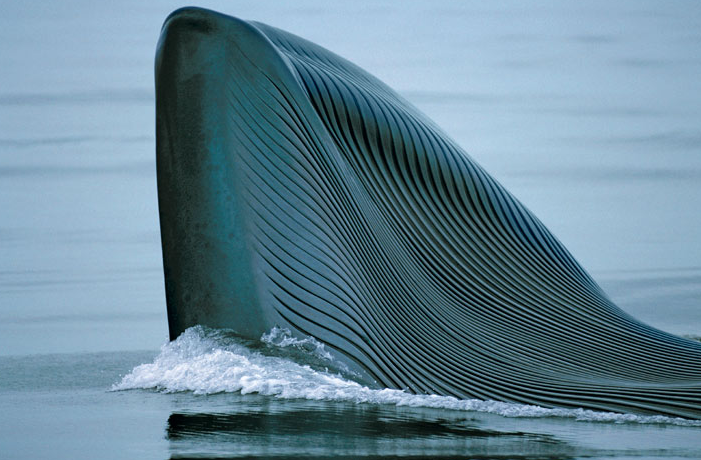Beautiful, isn’t it? And beautifully engineered: the sleek design, the precisely machined pleats in the plastic surface, the undulating surface transferring energy back to the water as the strong prow slices through the water–these are the marks of technological prowess taken to near perfection.
Or would be, if it were a machine. Instead, you are looking at a whale opening its jaw to channel water and krill into its feeding pouch. But are you really seeing what has just been described? I still don’t quite see an animal feeding. I see an elegantly complex shape that is further distinguished by beautiful lines carrying a waveform along a dazzling array of parallel lines. I see an astonishing combination of strength and suppleness, and I see something that is at once a model of precision and completely organic. The structure is both a bold assertion, a statement rising above the uniformly horizontal surface of the sea, and yet profoundly a part of its environment, so deeply adapted that is is part of a larger harmony. And, of course, it is both completely functional and seemingly so uniquely itself that is could be a work of art.
I don’t mean to rhapsodize, but words do come up a bit short when captioning this photograph. Or at least it’s fair to say that my abilities as a stylist don’t begin to match the beauty evident in the image. The point is not simply to marvel, however. I do think that awe and similar emotions are not only appropriate but also necessary to understand what is before our eyes, but that is not enough. This photograph provides an opportunity to reflect on why “design” need not be surrendered entirely to pseudo-science, and why visual media provide important resources for seeing how nature works and how human beings might live in closer harmony with natural processes.
The image could have been of a submarine or other craft built to imitate a whale’s capabilities. Or perhaps it could inspire any number of other analogies and applications, whether in agriculture, building ventilation, whatever. A friend and I recently played a game where I would send him an image from nature without comment and he would reply with another of a machine: say, a bird and a plane, etc. It quickly became evident that we could go on a very long time, and for the simple reason that our modern, industrialized civilization already had become very proficient at imitating nature.
To a point, that is, for we know very well just how out of whack that civilization is with the deep processes of nature–the processes that must be understood if we are to achieve an adequate degree of sustainability. How to feed everyone, for example, without adding to global warming that in turn makes it harder to feed everyone. That is but one example, and the list of what needs to be done is a very long one. Perhaps one more item should be added, however: to look, marvel, and see what nature already knows. The knowledge, that is, that is locked up in our capacity to see nature’s beauty.
Photograph by Hiroya Minakuchi, Minden Pictures, via National Geographic.

Consider too Alfred Stieglitz’s “Equivalents” series. Here’s a video about that from the film “Alfred Stieglitz: The Eloquent Eye.”
http://www.youtube.com/watch?v=ZxsgL6QGpVY
The best engineering and design I see is evident in nature. The most efficient structures, those that combine elegant form and efficient function, are oak trees. To see what nature already knows, in wise sustainability, would help us work with nature instead of against it. Unfortunately, this country hasn’t lost its ideological foundation of conquering nature, rather than learning from it. A nation that “tamed” the West, and attempted inappropriate agricultural industry on the Great Plains, one that grows beef on feed lots and channelizes nearly every urban stream and marvels at nature’s destruction of a major city built below sea level just doesn’t get it. We have a lot to learn.We are best at containment and constraint of nature.